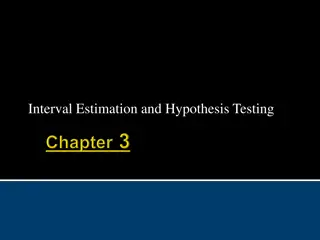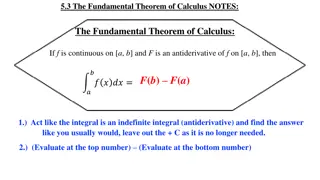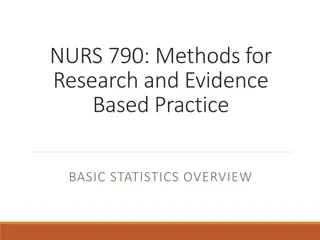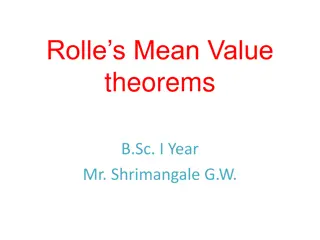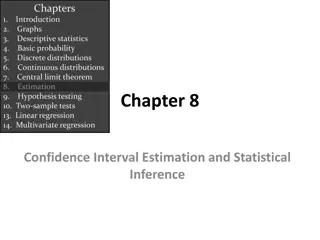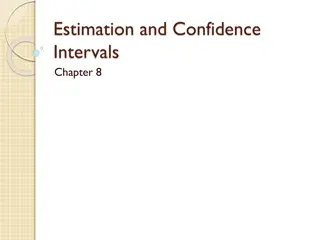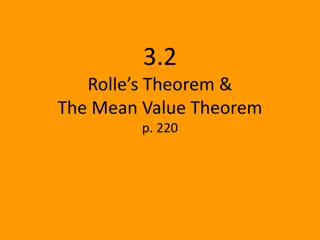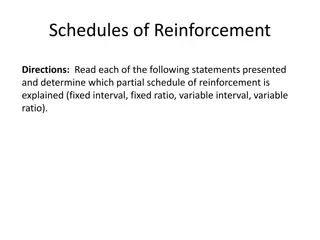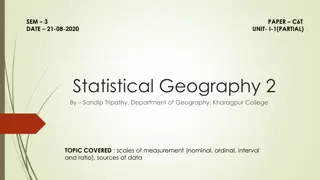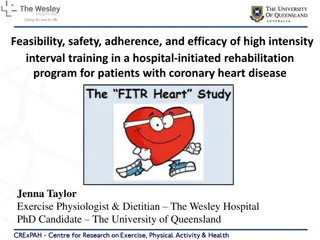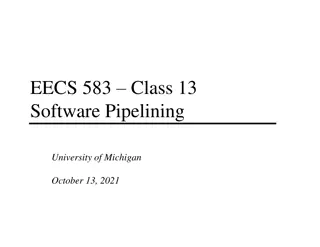Interval Estimation and Hypothesis Testing in Statistics
The concept of interval estimation and hypothesis testing in statistics involves techniques such as constructing interval estimators, performing hypothesis tests, determining critical values from t-distributions, and making probability statements. Assumptions must be met in linear regression models
2 views • 25 slides
The Fundamental Theorem of Calculus
The Fundamental Theorem of Calculus states that if a function is continuous on an interval and has an antiderivative on that interval, then the integral of the function over the interval is equal to the difference of the antiderivative evaluated at the endpoints. This concept is further explored thr
1 views • 14 slides
Basic Statistics in Research and Evidence-Based Practice
Basic statistics play a crucial role in research and evidence-based practice. Descriptive statistics help summarize data, while inferential statistics make inferences about populations based on samples. Various types of statistics like hypothesis testing, correlation, confidence intervals, and signi
8 views • 15 slides
Solving the Professors to Coffee Lounge Problem: A Graph Theory Approach
An intriguing mathematical problem is presented where new faculty members at TIMS must be assigned to coffee lounge alcoves in a way that ensures no two new members meet after the first day. By constructing a graph based on meet-up timings, analyzing clashes, and determining intervals, this scenario
3 views • 19 slides
Rolle's Mean Value Theorem in Calculus
Rolle's Mean Value Theorem states that if a function is continuous in a closed interval, differentiable in the open interval, and the function values at the endpoints of the interval are equal, then there exists at least one point where the derivative of the function is zero. This theorem is verifie
2 views • 11 slides
Estimation and Statistical Inference in Data Analysis
Statistical inference involves acquiring information and drawing conclusions about populations from samples using estimation and hypothesis testing. Estimation determines population parameter values based on sample statistics, utilizing point and interval estimators. Interval estimates, known as con
3 views • 41 slides
Estimation and Confidence Intervals in Statistics
Explore the concepts of point estimates and interval estimates in statistics. Learn how to construct confidence intervals for the mean and proportion, consider the finite population correction factor, choose an appropriate sample size, and calculate confidence levels using known population standard
3 views • 25 slides
Decision-to-Delivery Interval of Emergency Caesarean Sections and Maternal/Neonatal Outcomes at Thika Level 5 Hospital
Decision-to-Delivery Interval (DDI) study at Thika Level 5 Hospital examined 419 EMCS cases. The median DDI was 248 minutes, with 91.6% exceeding 75 minutes. Maternal complications were 6%, neonatal complications included MAS, RDS, birth asphyxia, and perinatal deaths. Prolonged DDI was associated w
1 views • 9 slides
The Physics of Yellow Change Interval at ITE International Convention
Delve into the intricate details of the physics behind the yellow change interval at the ITE International Convention. Explore the critical points, braking points, comfortable stopping distances, and the concept of unimpeded through movements. Learn about the equation for turning vehicles decelerati
3 views • 14 slides
Rolle's Theorem and The Mean Value Theorem in Calculus
Rolle's Theorem states that for a continuous and differentiable function on a closed interval with equal function values at the endpoints, there exists at least one point where the derivative is zero. The Mean Value Theorem asserts that for a continuous and differentiable function on an interval, th
3 views • 5 slides
Greedy Algorithms in Interval Scheduling
Interval Scheduling is a classic algorithmic problem where the goal is to schedule a set of tasks to maximize efficiency without overlap. Greedy algorithms play a crucial role in solving this problem by making locally optimal choices at each step. The concept of greediness, building the solution ste
5 views • 24 slides
Confidence Intervals and Interval Estimation in Statistics
Understanding how to compute confidence intervals is crucial in statistics to estimate parameters accurately. Confidence intervals are constructed based on sample size, mean estimate, estimated standard error, and chosen level of confidence. Using the Student-T distribution for sampling distribution
4 views • 14 slides
Schedules of Reinforcement
Different schedules of reinforcement, including fixed ratio, fixed interval, variable ratio, and variable interval, are explained through relatable scenarios like buying lottery tickets, taking breaks, and receiving allowances. By identifying these reinforcement schedules, individuals can better und
0 views • 4 slides
Solving Train Track Problems Using Interval Graphs and Graph Coloring
Presented by Manvitha Nellore, this content addresses real-world train track problems in busy cities by proposing solutions through interval graphs and graph theory. The approach involves allotting tracks to trains by scheduling with time intervals to avoid conflicts. An interval graph is defined, a
5 views • 15 slides
Solving the Tropical Fish Tank Assignment Puzzle
Dive into the challenge of assigning tropical fish into tanks efficiently based on predator-prey relationships, water conditions, and compatibility. Explore the graph theory approach to determine the minimum number of tanks needed, construct a graph representing fish compatibility, identify the prob
3 views • 13 slides
Effective HIIT Workout Strategies for Cardio-Respiratory Fitness
Utilize timed interval workouts, longer work interval sessions, and longer rest interval routines to boost cardio-respiratory fitness through high-intensity interval training (HIIT). Enhance efficiency, endurance, and speed while reducing the risk of overuse injuries. Interval training increases aer
4 views • 6 slides
Geometric Discrepancy Theory: Online Vector Balancing & Interval Balancing Study
Study covers online geometric discrepancy theory with applications in fair division, focusing on vector balancing, interval balancing, and Tusnady's problem. Concepts explored include offline vs online approaches, interval balancing techniques, and linear algebraic views.
3 views • 29 slides
Estimation and Confidence Intervals
Learn the difference between point and interval estimation, estimate population parameters, factors affecting confidence intervals, interpretation of interval estimates, and more in statistical estimation and confidence intervals.
0 views • 53 slides
Statistical Geography 2
Scales of measurement in statistical geography play a crucial role in quantifying characteristics and phenomena. This covers nominal, ordinal, interval, and ratio scales, each with distinct properties and applications. Nominal scale involves non-numeric labels, while ordinal scale represents ordered
0 views • 11 slides
High Intensity Interval Training in Hospital-Based Cardiac Rehabilitation
This study examines the feasibility, safety, adherence, and efficacy of implementing High Intensity Interval Training (HIIT) in a hospital-initiated rehabilitation program for patients with coronary heart disease. It compares HIIT with Moderate Intensity Continuous Training (MICT) in terms of cardio
0 views • 35 slides
Software Pipelining at University: Terminology and Resource Usage
Dive into the world of software pipelining with a focus on initiation interval and resource usage legality. Understand the terminologies like Initiation Interval (II) and Stage Count (SC), and learn about the importance of ensuring resource usage legality in software pipelining. Explore the concepts
2 views • 40 slides
Interval Scheduling and Greedy Algorithms
Explore the concepts of interval scheduling, job compatibility, greedy algorithms, and interval partitioning as discussed by Yin Tat Lee in CSE 421. Understand the application of earliest finish time strategy in scheduling jobs and the optimal nature of greedy algorithms. Discover how to find the ma
4 views • 24 slides
Guard Interval Coordination for Coordinated Beamforming
This document discusses guard interval coordination for coordinated beamforming in IEEE 802.11 networks. It explores methods of coordination for effective beamforming strategies and transmission synchronization in multi-AP environments.
5 views • 9 slides
Minimizing Aggregate Movements for Interval Coverage
This research addresses the problem of minimizing aggregate movements for interval coverage using sensors to cover a segment with optimal energy efficiency. It explores various scenarios, previous work, and results, offering insights into movement minimization strategies and lower bounds for the pro
1 views • 30 slides
Confidence Intervals for Mean Adult Body Temperature
Learn how to perform a 95% confidence interval to predict the mean adult body temperature using a sample of randomly chosen temperatures. Verify if assumptions/conditions are satisfied, decide between z or t and calculate the interval. Graphical representation, center, and spread determination are c
1 views • 14 slides
Estimation in Statistics: Point and Interval Estimates
In statistics, estimation involves determining the value of unknown population parameters based on sample data. Point estimates provide single values as estimates, while interval estimates give ranges within which the true parameter is likely to lie. This chapter delves into the concepts of point an
0 views • 26 slides
Greedy Algorithms for Interval Scheduling
Interval scheduling with greedy algorithms. Explore how to maximize meeting schedules by sorting and selecting meetings based on ending times. Proof of correctness and optimizing meeting selections illustrated.
5 views • 22 slides
Measurement Scales in Data Analysis
This informative content delves into the various types of measurement scales, namely nominal, ordinal, interval, and ratio scales, elucidating their unique properties and applications in data analysis. It discusses the characteristics of each scale, such as the presence of labels in nominal scales,
4 views • 16 slides
Essential Music Theory: Scales, Arpeggios, and Interval Practice
Dive into the fundamentals of music theory with a focus on scales, arpeggios, and interval training. Understand Major and Minor scale structures, learn to play arpeggios, and enhance your musical ear for better performance. Explore the importance of regular scale practice in mastering different musi
0 views • 12 slides
Atlanto-Occipital Dissociation: Traumatic Mechanism and Imaging Findings
Atlanto-Occipital Dissociation (AOD) is a severe neck injury resulting from high-velocity trauma. This condition has a high mortality rate, with key imaging findings including basion-dens interval, atlanto-occipital interval, and condylar sum measurements on CT scans. Ligamentous disruption at the c
0 views • 4 slides
Optimizing Coin Change and Interval Scheduling Algorithms
Explore the optimality of greedy algorithms in coin change and interval scheduling problems. Learn how to minimize the number of coins needed for change and maximize job processing with non-overlapping intervals. Understand when the greedy algorithm works and when dynamic programming may be a better
2 views • 62 slides
Dynamic Programming Explained: From Greedy Approaches to Weighted Interval Scheduling
Explore the concepts of dynamic programming in algorithms, from greedy approaches to weighted interval scheduling problems. Understand how dynamic programming efficiently solves complex problems by breaking them down into smaller, manageable subproblems. Learn about the similarities and differences
1 views • 22 slides
Algorithm Concepts in Interval Scheduling Problem
Explore the concept of interval scheduling problem in algorithms, where resources are allocated efficiently based on time intervals. Learn about greedy algorithms, sorting techniques, and efficient scheduling strategies.
1 views • 80 slides
Computational Geometry Techniques for Interval and Segment Trees
Explore the concepts of interval and segment trees in computational geometry, including windowing and interval partitioning, with explanations on construction, space complexity, and query time.
2 views • 17 slides
Advanced Data Structures for Set of Intervals
Explore tree structures like Interval Trees and Segment Trees designed by experts like Edelsbrunner, McCreight, and Bentley for efficient storage and retrieval of interval data sets. Learn about Orthogonal Range Trees and canonical interval decomposition for higher-dimensional tasks. Discover the po
2 views • 12 slides
Guard Interval Proposal for IEEE 802.11-25/0849r0 CID 368
This document proposes introducing a new Guard Interval option for Distributed Remote Units (DRUs) in IEEE 802.11 standards, aiming to enhance flexibility and performance. It discusses the background, benefits, and implications of supporting different Guard Interval values to optimize power gains an
0 views • 10 slides
Symbol Blocking and Guard Interval Definition for SC MIMO in 11ay
This presentation discusses the proposal for symbol blocking and Guard Interval (GI) definition for MIMO SC PHY in 11ay, extending the existing SISO definition. It covers the MIMO EDMG PPDU format, proposed Guard Interval types, and details of Single Channel SU-MIMO and MU-MIMO frame structures.
0 views • 19 slides
Effect of 4-Stab Training with Interval Method on Fencing Performance
Explore the impact of 4-stab training utilizing the interval method on accuracy and speed of stabbing with degen weapons at Pakansari Fencing Club. The study aims to enhance fencing athletes' performance by improving their stabbing techniques through targeted training methods. Investigate the effect
1 views • 9 slides
Computational Geometry Techniques in Windowing and Interval Trees
Explore the concepts of windowing and interval trees in computational geometry, including interval tree construction, query theorems, and segment tree partitioning. Learn how these techniques can efficiently process line segments, intervals, and query points in spatial data structures.
4 views • 17 slides
Music Perception Study on Interval Size & Key Membership
Explore the effects of interval size and key membership on perceiving wrong notes in music across different cultures. Prior research and pilot studies conducted by Besson & Fata provide insights into the behavioral and ERP responses of musicians and nonmusicians to various types of wrong notes in We
2 views • 32 slides
